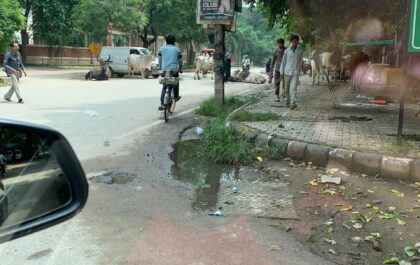Swallowing the Sun by Lakshmi Murdeshwar Puri relates the story of two Maharashtrian sisters, Kamala and Malathi, set against the backdrop of the freedom movement. It describes their early education, and going to university in Mumbai — Elphinstone College — when few girls ventured into higher education, and their achievements.
The discussion on the book took a languid turn, for it raised no controversies or difficult, provocative issues. In school in 1918 the sisters get involved in a class fight with the bully Bhika who says no girls should be allowed to attend school and so one of them dares him to a fight. Malathi takes him on and gives him as good as she gets. After that then the ragging stops.
The experience of the village girls at the boarding school is documented thus: It was time for Kamala and Malathi to round up their life in Ahilya Ashram and prepare for the next yuga. They couldn’t believe they had spent several years here! They came as simple village girls and were going out as educated and self- aware individuals.
Not surprisingly in university one of the sisters (Malathi) gets romantically involved with one of the students, Guru, and from him we get an idea about the evolution of the freedom movement, and who constituted its leadership. He observes: Well don‘t forget, the babu classes — Westernised Oriental Gentlemen [WOGS] — the army of Macaulay’s westernised collaborators like us, now feel the racial injustice of British rule actually. They are restless and have the most will for freedom. And that’ s what the Congress Party also seeks to tap. The British need them to be their instruments of governance, but they can and are turning the tables on them if they don’t change things like Indians not being able to join the ICS on equal terms. My father testifies to the discrimination Indian lawyers and litigants alike face in the courts.
Malathi’s encounter with Gandhiji is worth recounting here. Page 275: She sat down cross- legged in front of him. Malathi’s heart pumped like a goldsmith’s bellow. She summoned up courage and said ‘ Bapuji, I feel privileged to meet you in person. Why would I, a woman who is already possessed by your spirit of nationalism, be afraid of further contamination?
Malathi goes on to add: I have been participating in your satyagraha activities. I was part of the Yusuf Meherally led Simon Commission protest which was lathi- charged. Dare I say that it‘s courage, not fear, that you ignite in us— courage to be the wheels of the chariot of Indian independence equally with men…….
In this vein the book unfolds the story of the fight for independence and the role that the protagonists of the book played in the freedom movement.
During the discussion, Dr Gautam Vohra observed that the author was at pains to develop the theme that the independence movement enabled the women to emerge out of their restricted roles and enter the public space. Nimal Thadani, Preeti Verma, Anita Katyal and Poonam Bali made similar and related observations. Anil Nauriya, Siddo Deva, Harish Sood, Ajay Dua dwelt on the issue of the characterisation of the women. They felt that the author could have done more to define and strengthen the personality of women, give them more substance. Even the men appeared tame observers, rather than fiery individuals on the warpath demanding India’s independence.
Sadhna Kumar and Kavita Charanji observed that the author was perhaps fearful of dramatisation. She invariably took the middle path and maybe this was the reason why the story lacked the dramatic touch and did not rise to the heights. And in such fashion the discussion drew to a close.



Popular Stories
Football Tournament @Princeton
More Than a Festival: The Art and Power of Durga Puja
Personality of the Month- ‘Dr Usha Mediratta’
Stray Cattle Menace In Front of Galleria
The Chronicles of Malibu Towne: A Mosquito’s Tale
“Senior Living Is Not An Old Age Home” say Mr & Mrs Bose
Recent Stories from Nearby
- Araya Samaj Hauz Khas New Delhi December 27, 2024
- AGM At Adhya Jha December 27, 2024
- Petty Thefts on the Rise December 27, 2024
- Water Sprinklers in SDA December 27, 2024
- Town Hall Meeting With Parmila Tokas December 27, 2024







